Supply Chain Management Research Report: Magnit Group, Russia
VerifiedAdded on 2023/06/03
|65
|12957
|452
Report
AI Summary
This research report investigates supply chain management (SCM) within the Magnit Group, a grocery retail company operating in Russia, examining the impact of integration and globalization in the age of e-business. The study analyzes key SCM components like logistics, supplier evaluation, and inventory management, emphasizing the importance of continuous goods flow. The research incorporates literature reviews on SCM, Sales Operating Plan, e-business, and collaborative systems. Data collection involved surveys and interviews with Magnit Group employees, focusing on areas requiring improvement, such as supplier performance and communication. Findings suggest a need for the company to improve in specific areas to optimize workforce utilization and long-term profitability. The report uses quantitative and qualitative data analysis to draw conclusions and provides recommendations for improvement.
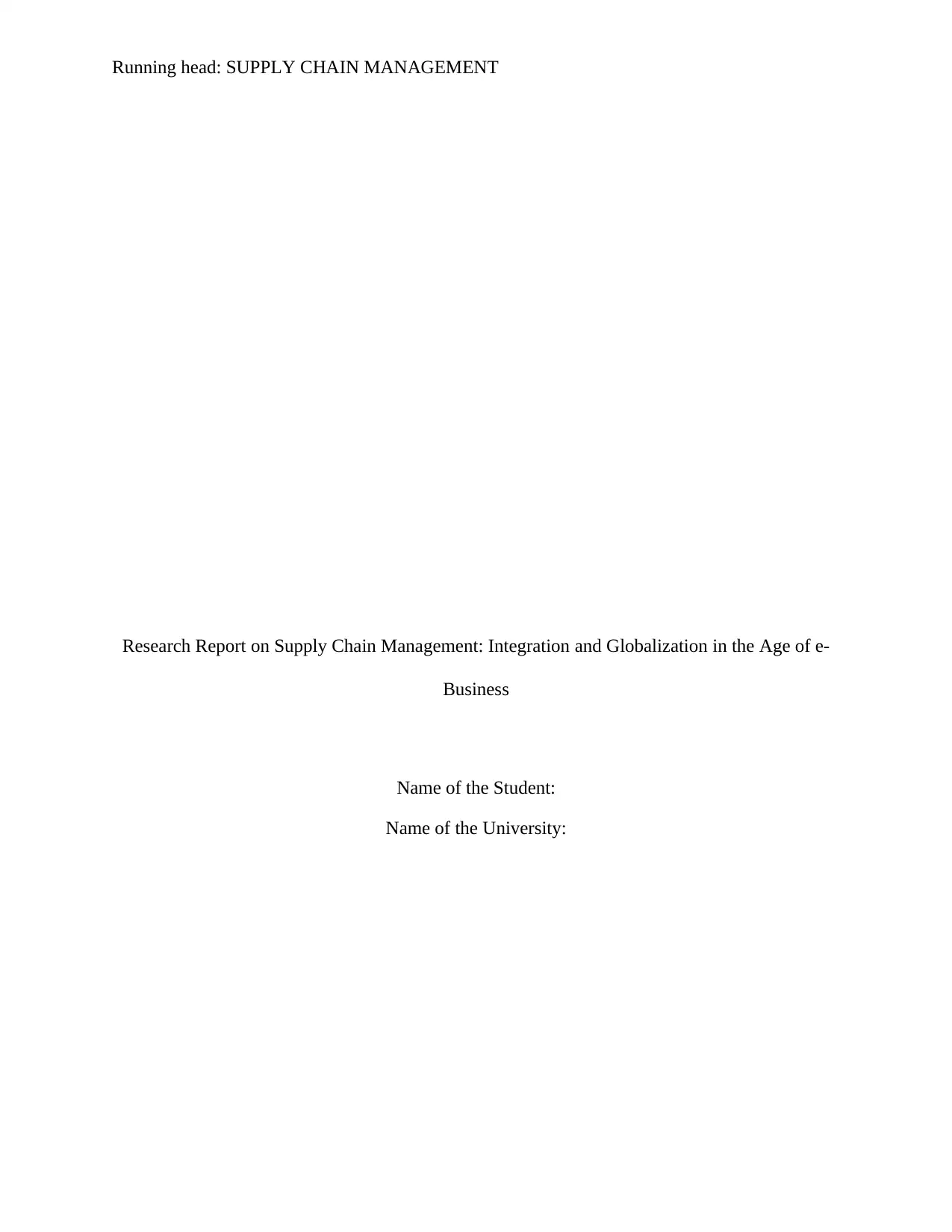
Running head: SUPPLY CHAIN MANAGEMENT
Research Report on Supply Chain Management: Integration and Globalization in the Age of e-
Business
Name of the Student:
Name of the University:
Research Report on Supply Chain Management: Integration and Globalization in the Age of e-
Business
Name of the Student:
Name of the University:
Paraphrase This Document
Need a fresh take? Get an instant paraphrase of this document with our AI Paraphraser
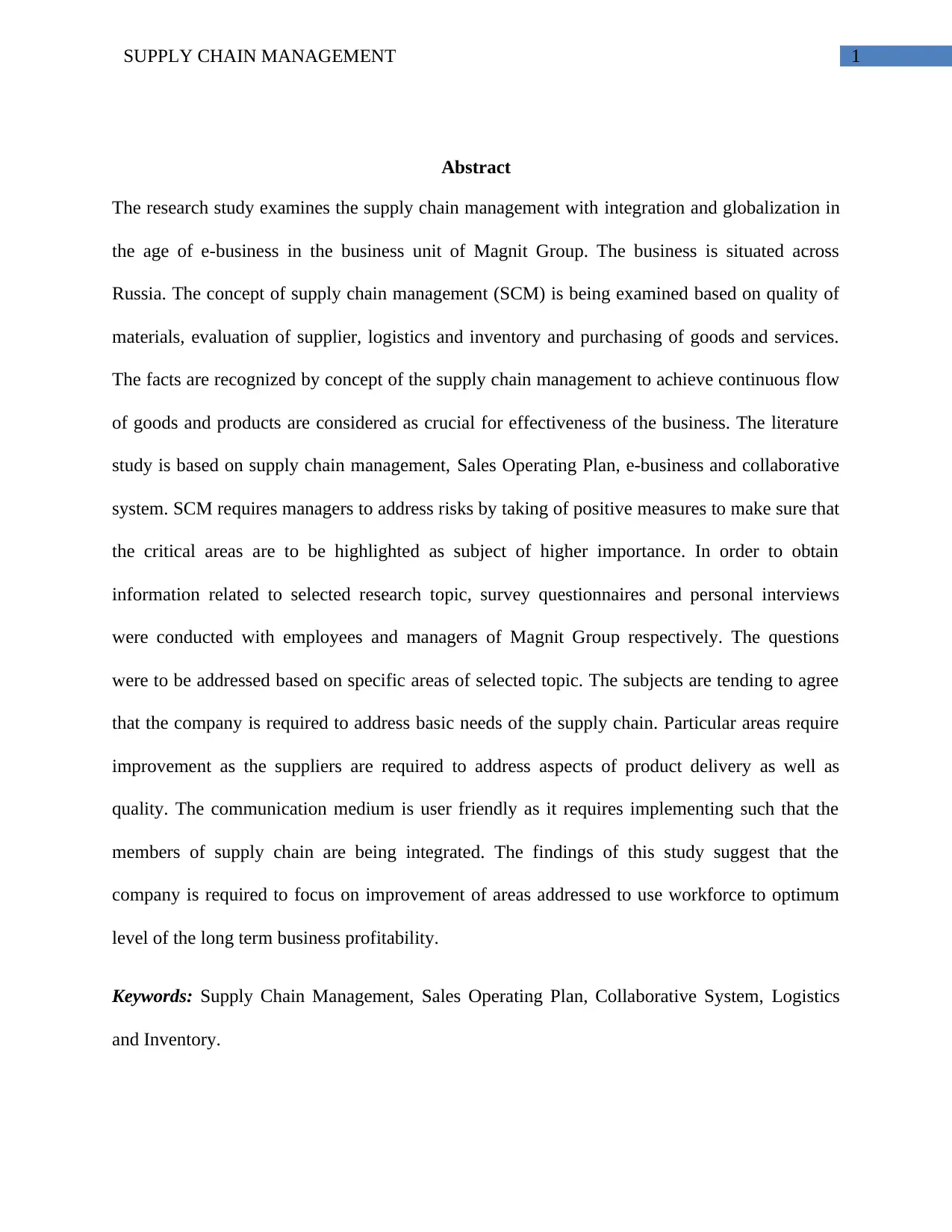
1SUPPLY CHAIN MANAGEMENT
Abstract
The research study examines the supply chain management with integration and globalization in
the age of e-business in the business unit of Magnit Group. The business is situated across
Russia. The concept of supply chain management (SCM) is being examined based on quality of
materials, evaluation of supplier, logistics and inventory and purchasing of goods and services.
The facts are recognized by concept of the supply chain management to achieve continuous flow
of goods and products are considered as crucial for effectiveness of the business. The literature
study is based on supply chain management, Sales Operating Plan, e-business and collaborative
system. SCM requires managers to address risks by taking of positive measures to make sure that
the critical areas are to be highlighted as subject of higher importance. In order to obtain
information related to selected research topic, survey questionnaires and personal interviews
were conducted with employees and managers of Magnit Group respectively. The questions
were to be addressed based on specific areas of selected topic. The subjects are tending to agree
that the company is required to address basic needs of the supply chain. Particular areas require
improvement as the suppliers are required to address aspects of product delivery as well as
quality. The communication medium is user friendly as it requires implementing such that the
members of supply chain are being integrated. The findings of this study suggest that the
company is required to focus on improvement of areas addressed to use workforce to optimum
level of the long term business profitability.
Keywords: Supply Chain Management, Sales Operating Plan, Collaborative System, Logistics
and Inventory.
Abstract
The research study examines the supply chain management with integration and globalization in
the age of e-business in the business unit of Magnit Group. The business is situated across
Russia. The concept of supply chain management (SCM) is being examined based on quality of
materials, evaluation of supplier, logistics and inventory and purchasing of goods and services.
The facts are recognized by concept of the supply chain management to achieve continuous flow
of goods and products are considered as crucial for effectiveness of the business. The literature
study is based on supply chain management, Sales Operating Plan, e-business and collaborative
system. SCM requires managers to address risks by taking of positive measures to make sure that
the critical areas are to be highlighted as subject of higher importance. In order to obtain
information related to selected research topic, survey questionnaires and personal interviews
were conducted with employees and managers of Magnit Group respectively. The questions
were to be addressed based on specific areas of selected topic. The subjects are tending to agree
that the company is required to address basic needs of the supply chain. Particular areas require
improvement as the suppliers are required to address aspects of product delivery as well as
quality. The communication medium is user friendly as it requires implementing such that the
members of supply chain are being integrated. The findings of this study suggest that the
company is required to focus on improvement of areas addressed to use workforce to optimum
level of the long term business profitability.
Keywords: Supply Chain Management, Sales Operating Plan, Collaborative System, Logistics
and Inventory.

2SUPPLY CHAIN MANAGEMENT
Table of Contents
Chapter 1: Introduction....................................................................................................................6
1.1 Background and problem statement......................................................................................6
1.2 Purpose and scope of study....................................................................................................7
1.3 Research aim and objectives..................................................................................................7
1.4 Research justification.............................................................................................................8
1.5 Summarization of chosen research methods..........................................................................8
1.6 Report outline........................................................................................................................8
Chapter 2: Literature Review.........................................................................................................10
2.1 Introduction.....................................................................................................................10
2.2 Supply chain management (SCM) and Enterprise Resource Planning...............................10
2.3 Sales and Operations Planning (S&OP)..............................................................................13
2.4 E-business and E-commerce in Supply Chain Management...............................................14
2.5 Collaborative system based on supply chain.......................................................................15
2.6 Conceptual model and framework for the research.............................................................18
2.7 Summary..............................................................................................................................19
Chapter 3: Research Methodology................................................................................................21
3.1 Research design/methodology.............................................................................................21
3.2 Research approach...............................................................................................................21
3.3 Target population and sampling..........................................................................................22
Table of Contents
Chapter 1: Introduction....................................................................................................................6
1.1 Background and problem statement......................................................................................6
1.2 Purpose and scope of study....................................................................................................7
1.3 Research aim and objectives..................................................................................................7
1.4 Research justification.............................................................................................................8
1.5 Summarization of chosen research methods..........................................................................8
1.6 Report outline........................................................................................................................8
Chapter 2: Literature Review.........................................................................................................10
2.1 Introduction.....................................................................................................................10
2.2 Supply chain management (SCM) and Enterprise Resource Planning...............................10
2.3 Sales and Operations Planning (S&OP)..............................................................................13
2.4 E-business and E-commerce in Supply Chain Management...............................................14
2.5 Collaborative system based on supply chain.......................................................................15
2.6 Conceptual model and framework for the research.............................................................18
2.7 Summary..............................................................................................................................19
Chapter 3: Research Methodology................................................................................................21
3.1 Research design/methodology.............................................................................................21
3.2 Research approach...............................................................................................................21
3.3 Target population and sampling..........................................................................................22
⊘ This is a preview!⊘
Do you want full access?
Subscribe today to unlock all pages.

Trusted by 1+ million students worldwide
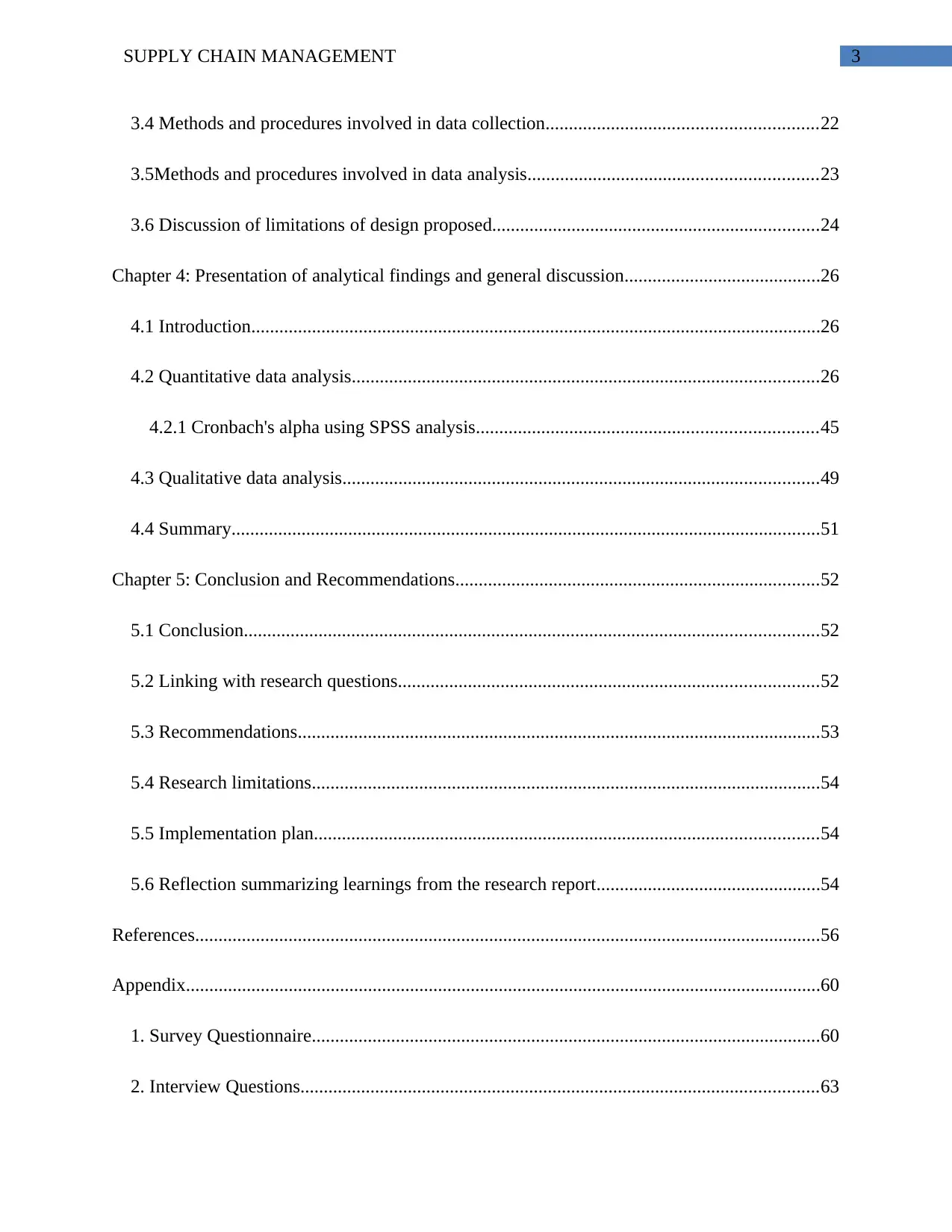
3SUPPLY CHAIN MANAGEMENT
3.4 Methods and procedures involved in data collection..........................................................22
3.5Methods and procedures involved in data analysis..............................................................23
3.6 Discussion of limitations of design proposed......................................................................24
Chapter 4: Presentation of analytical findings and general discussion..........................................26
4.1 Introduction..........................................................................................................................26
4.2 Quantitative data analysis....................................................................................................26
4.2.1 Cronbach's alpha using SPSS analysis.........................................................................45
4.3 Qualitative data analysis......................................................................................................49
4.4 Summary..............................................................................................................................51
Chapter 5: Conclusion and Recommendations..............................................................................52
5.1 Conclusion...........................................................................................................................52
5.2 Linking with research questions..........................................................................................52
5.3 Recommendations................................................................................................................53
5.4 Research limitations.............................................................................................................54
5.5 Implementation plan............................................................................................................54
5.6 Reflection summarizing learnings from the research report................................................54
References......................................................................................................................................56
Appendix........................................................................................................................................60
1. Survey Questionnaire.............................................................................................................60
2. Interview Questions...............................................................................................................63
3.4 Methods and procedures involved in data collection..........................................................22
3.5Methods and procedures involved in data analysis..............................................................23
3.6 Discussion of limitations of design proposed......................................................................24
Chapter 4: Presentation of analytical findings and general discussion..........................................26
4.1 Introduction..........................................................................................................................26
4.2 Quantitative data analysis....................................................................................................26
4.2.1 Cronbach's alpha using SPSS analysis.........................................................................45
4.3 Qualitative data analysis......................................................................................................49
4.4 Summary..............................................................................................................................51
Chapter 5: Conclusion and Recommendations..............................................................................52
5.1 Conclusion...........................................................................................................................52
5.2 Linking with research questions..........................................................................................52
5.3 Recommendations................................................................................................................53
5.4 Research limitations.............................................................................................................54
5.5 Implementation plan............................................................................................................54
5.6 Reflection summarizing learnings from the research report................................................54
References......................................................................................................................................56
Appendix........................................................................................................................................60
1. Survey Questionnaire.............................................................................................................60
2. Interview Questions...............................................................................................................63
Paraphrase This Document
Need a fresh take? Get an instant paraphrase of this document with our AI Paraphraser

4SUPPLY CHAIN MANAGEMENT
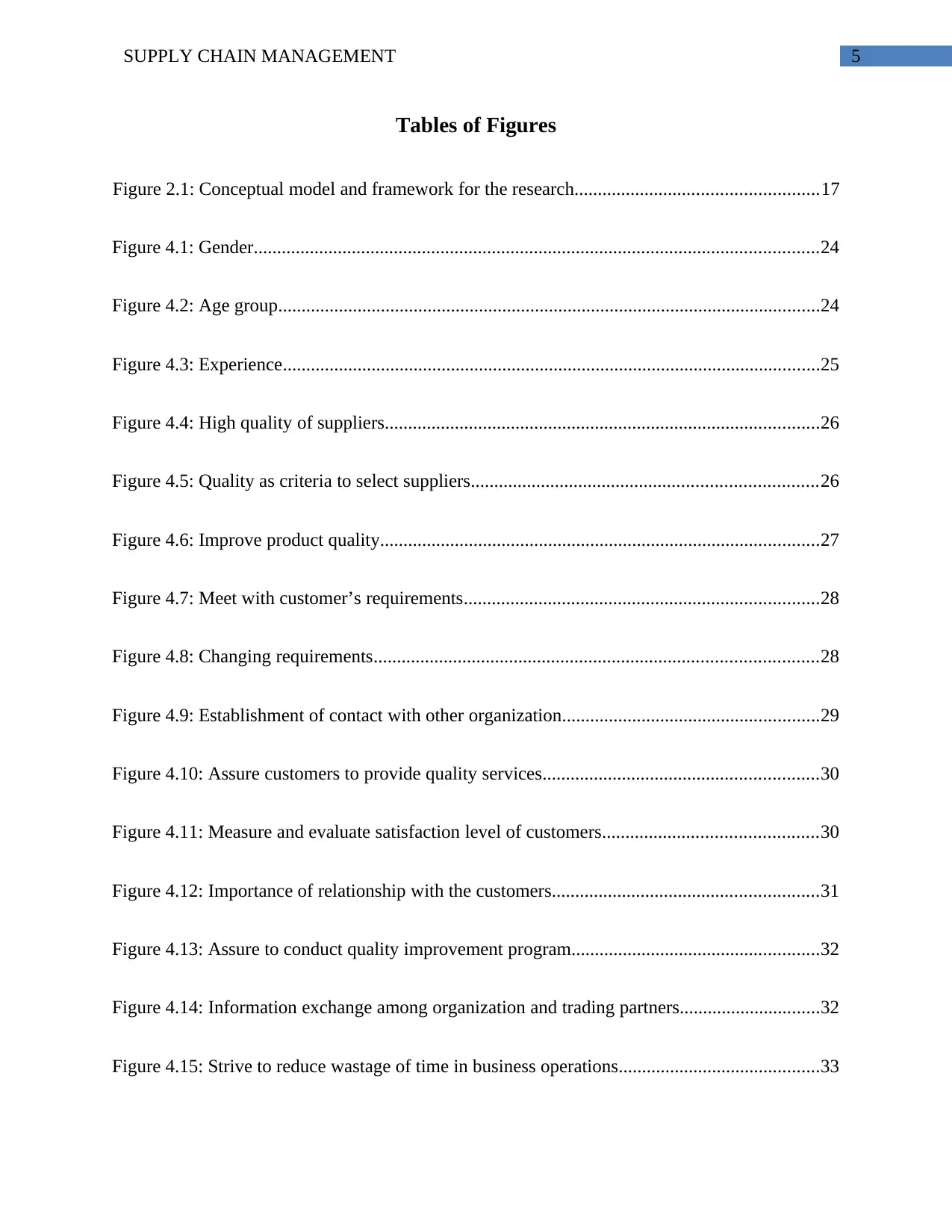
5SUPPLY CHAIN MANAGEMENT
Tables of Figures
Figure 2.1: Conceptual model and framework for the research....................................................17
Figure 4.1: Gender.........................................................................................................................24
Figure 4.2: Age group....................................................................................................................24
Figure 4.3: Experience...................................................................................................................25
Figure 4.4: High quality of suppliers.............................................................................................26
Figure 4.5: Quality as criteria to select suppliers..........................................................................26
Figure 4.6: Improve product quality..............................................................................................27
Figure 4.7: Meet with customer’s requirements............................................................................28
Figure 4.8: Changing requirements...............................................................................................28
Figure 4.9: Establishment of contact with other organization.......................................................29
Figure 4.10: Assure customers to provide quality services...........................................................30
Figure 4.11: Measure and evaluate satisfaction level of customers..............................................30
Figure 4.12: Importance of relationship with the customers.........................................................31
Figure 4.13: Assure to conduct quality improvement program.....................................................32
Figure 4.14: Information exchange among organization and trading partners..............................32
Figure 4.15: Strive to reduce wastage of time in business operations...........................................33
Tables of Figures
Figure 2.1: Conceptual model and framework for the research....................................................17
Figure 4.1: Gender.........................................................................................................................24
Figure 4.2: Age group....................................................................................................................24
Figure 4.3: Experience...................................................................................................................25
Figure 4.4: High quality of suppliers.............................................................................................26
Figure 4.5: Quality as criteria to select suppliers..........................................................................26
Figure 4.6: Improve product quality..............................................................................................27
Figure 4.7: Meet with customer’s requirements............................................................................28
Figure 4.8: Changing requirements...............................................................................................28
Figure 4.9: Establishment of contact with other organization.......................................................29
Figure 4.10: Assure customers to provide quality services...........................................................30
Figure 4.11: Measure and evaluate satisfaction level of customers..............................................30
Figure 4.12: Importance of relationship with the customers.........................................................31
Figure 4.13: Assure to conduct quality improvement program.....................................................32
Figure 4.14: Information exchange among organization and trading partners..............................32
Figure 4.15: Strive to reduce wastage of time in business operations...........................................33
⊘ This is a preview!⊘
Do you want full access?
Subscribe today to unlock all pages.

Trusted by 1+ million students worldwide
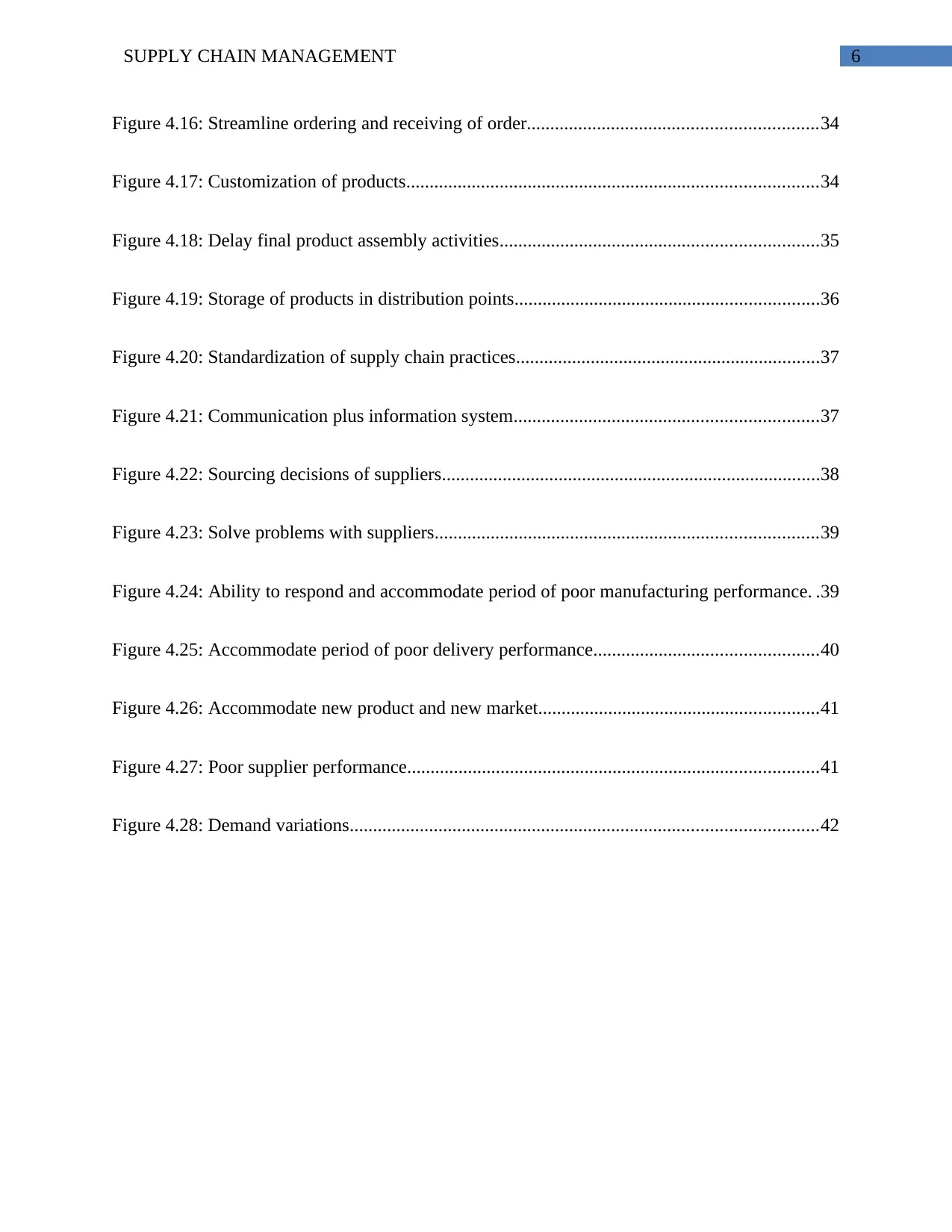
6SUPPLY CHAIN MANAGEMENT
Figure 4.16: Streamline ordering and receiving of order..............................................................34
Figure 4.17: Customization of products........................................................................................34
Figure 4.18: Delay final product assembly activities....................................................................35
Figure 4.19: Storage of products in distribution points.................................................................36
Figure 4.20: Standardization of supply chain practices.................................................................37
Figure 4.21: Communication plus information system.................................................................37
Figure 4.22: Sourcing decisions of suppliers.................................................................................38
Figure 4.23: Solve problems with suppliers..................................................................................39
Figure 4.24: Ability to respond and accommodate period of poor manufacturing performance. .39
Figure 4.25: Accommodate period of poor delivery performance................................................40
Figure 4.26: Accommodate new product and new market............................................................41
Figure 4.27: Poor supplier performance........................................................................................41
Figure 4.28: Demand variations....................................................................................................42
Figure 4.16: Streamline ordering and receiving of order..............................................................34
Figure 4.17: Customization of products........................................................................................34
Figure 4.18: Delay final product assembly activities....................................................................35
Figure 4.19: Storage of products in distribution points.................................................................36
Figure 4.20: Standardization of supply chain practices.................................................................37
Figure 4.21: Communication plus information system.................................................................37
Figure 4.22: Sourcing decisions of suppliers.................................................................................38
Figure 4.23: Solve problems with suppliers..................................................................................39
Figure 4.24: Ability to respond and accommodate period of poor manufacturing performance. .39
Figure 4.25: Accommodate period of poor delivery performance................................................40
Figure 4.26: Accommodate new product and new market............................................................41
Figure 4.27: Poor supplier performance........................................................................................41
Figure 4.28: Demand variations....................................................................................................42
Paraphrase This Document
Need a fresh take? Get an instant paraphrase of this document with our AI Paraphraser
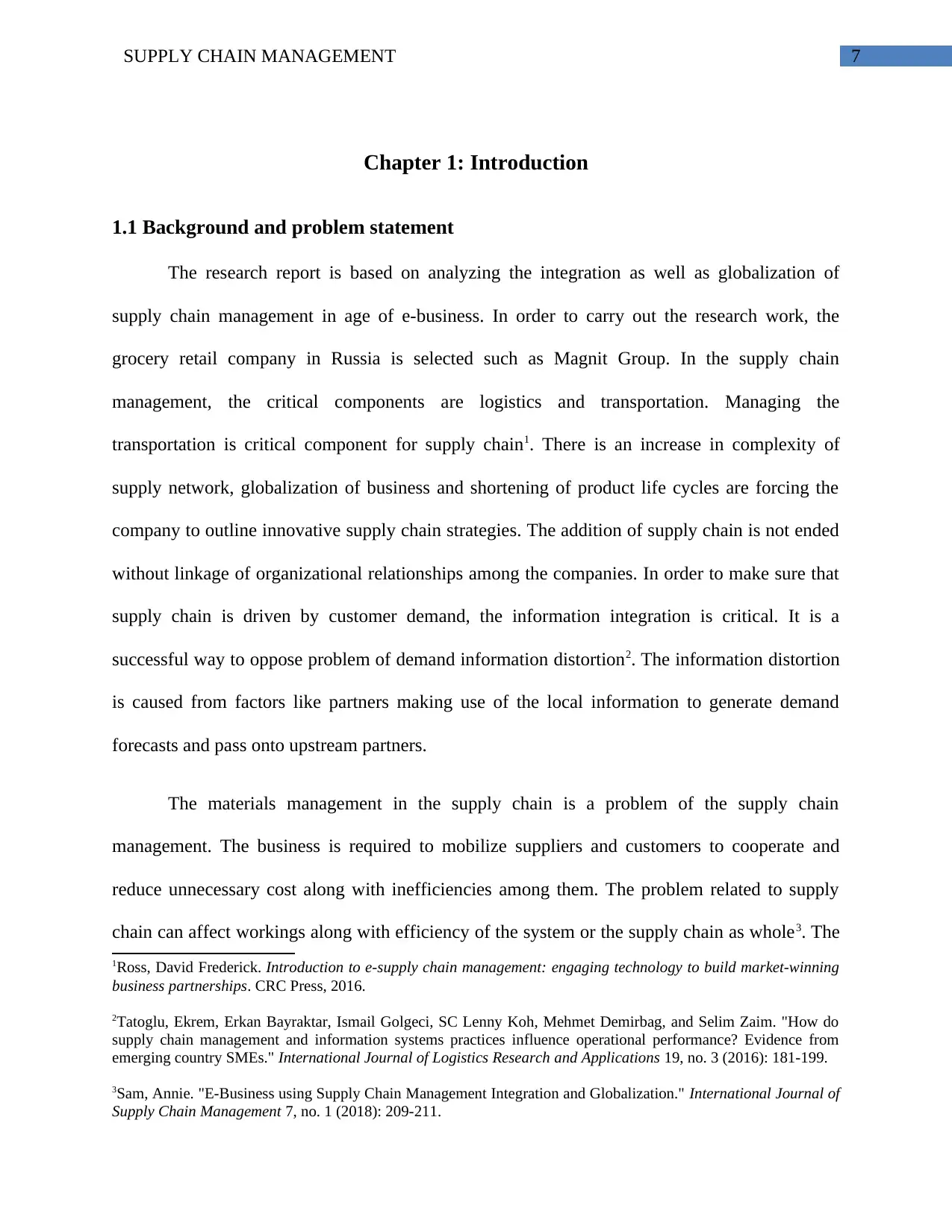
7SUPPLY CHAIN MANAGEMENT
Chapter 1: Introduction
1.1 Background and problem statement
The research report is based on analyzing the integration as well as globalization of
supply chain management in age of e-business. In order to carry out the research work, the
grocery retail company in Russia is selected such as Magnit Group. In the supply chain
management, the critical components are logistics and transportation. Managing the
transportation is critical component for supply chain1. There is an increase in complexity of
supply network, globalization of business and shortening of product life cycles are forcing the
company to outline innovative supply chain strategies. The addition of supply chain is not ended
without linkage of organizational relationships among the companies. In order to make sure that
supply chain is driven by customer demand, the information integration is critical. It is a
successful way to oppose problem of demand information distortion2. The information distortion
is caused from factors like partners making use of the local information to generate demand
forecasts and pass onto upstream partners.
The materials management in the supply chain is a problem of the supply chain
management. The business is required to mobilize suppliers and customers to cooperate and
reduce unnecessary cost along with inefficiencies among them. The problem related to supply
chain can affect workings along with efficiency of the system or the supply chain as whole3. The
1Ross, David Frederick. Introduction to e-supply chain management: engaging technology to build market-winning
business partnerships. CRC Press, 2016.
2Tatoglu, Ekrem, Erkan Bayraktar, Ismail Golgeci, SC Lenny Koh, Mehmet Demirbag, and Selim Zaim. "How do
supply chain management and information systems practices influence operational performance? Evidence from
emerging country SMEs." International Journal of Logistics Research and Applications 19, no. 3 (2016): 181-199.
3Sam, Annie. "E-Business using Supply Chain Management Integration and Globalization." International Journal of
Supply Chain Management 7, no. 1 (2018): 209-211.
Chapter 1: Introduction
1.1 Background and problem statement
The research report is based on analyzing the integration as well as globalization of
supply chain management in age of e-business. In order to carry out the research work, the
grocery retail company in Russia is selected such as Magnit Group. In the supply chain
management, the critical components are logistics and transportation. Managing the
transportation is critical component for supply chain1. There is an increase in complexity of
supply network, globalization of business and shortening of product life cycles are forcing the
company to outline innovative supply chain strategies. The addition of supply chain is not ended
without linkage of organizational relationships among the companies. In order to make sure that
supply chain is driven by customer demand, the information integration is critical. It is a
successful way to oppose problem of demand information distortion2. The information distortion
is caused from factors like partners making use of the local information to generate demand
forecasts and pass onto upstream partners.
The materials management in the supply chain is a problem of the supply chain
management. The business is required to mobilize suppliers and customers to cooperate and
reduce unnecessary cost along with inefficiencies among them. The problem related to supply
chain can affect workings along with efficiency of the system or the supply chain as whole3. The
1Ross, David Frederick. Introduction to e-supply chain management: engaging technology to build market-winning
business partnerships. CRC Press, 2016.
2Tatoglu, Ekrem, Erkan Bayraktar, Ismail Golgeci, SC Lenny Koh, Mehmet Demirbag, and Selim Zaim. "How do
supply chain management and information systems practices influence operational performance? Evidence from
emerging country SMEs." International Journal of Logistics Research and Applications 19, no. 3 (2016): 181-199.
3Sam, Annie. "E-Business using Supply Chain Management Integration and Globalization." International Journal of
Supply Chain Management 7, no. 1 (2018): 209-211.
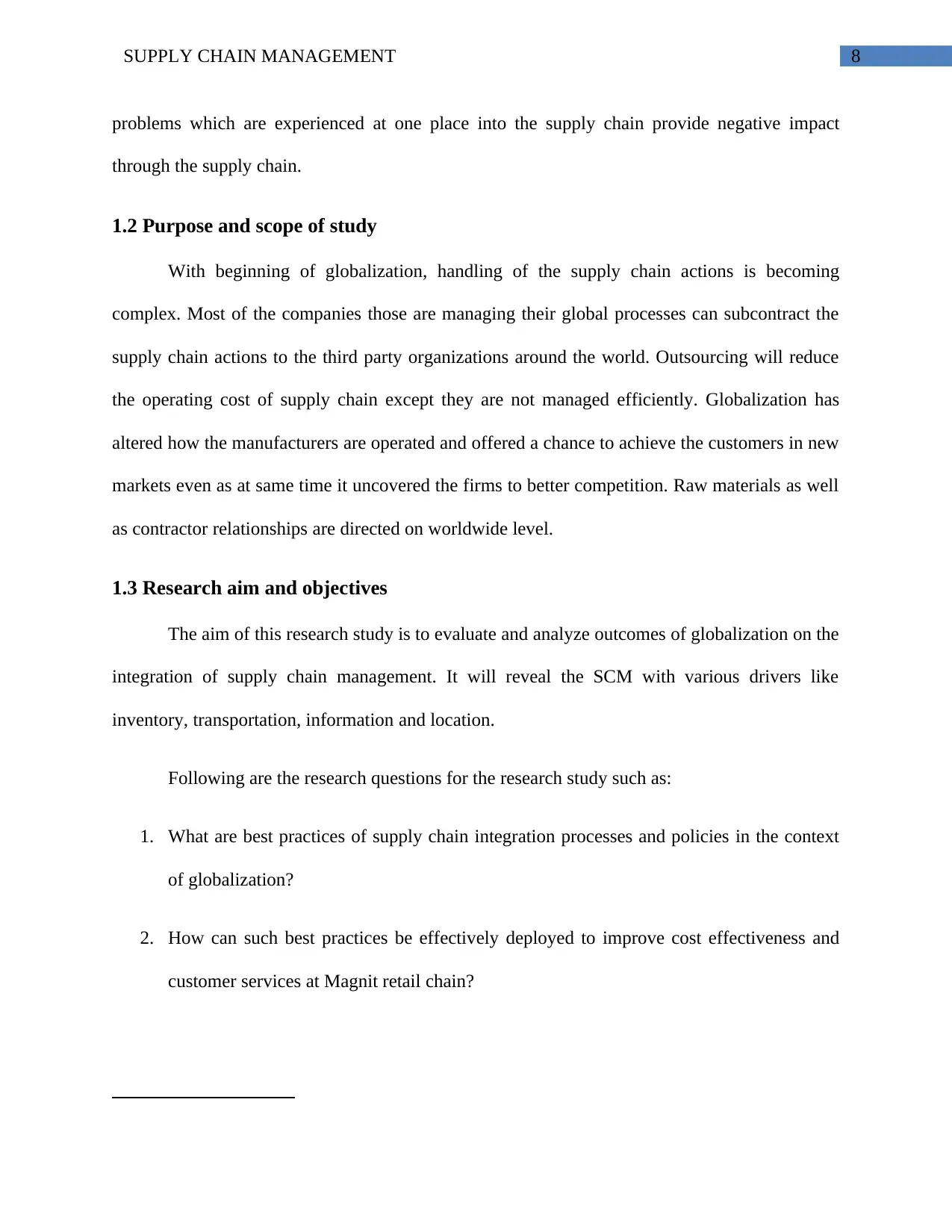
8SUPPLY CHAIN MANAGEMENT
problems which are experienced at one place into the supply chain provide negative impact
through the supply chain.
1.2 Purpose and scope of study
With beginning of globalization, handling of the supply chain actions is becoming
complex. Most of the companies those are managing their global processes can subcontract the
supply chain actions to the third party organizations around the world. Outsourcing will reduce
the operating cost of supply chain except they are not managed efficiently. Globalization has
altered how the manufacturers are operated and offered a chance to achieve the customers in new
markets even as at same time it uncovered the firms to better competition. Raw materials as well
as contractor relationships are directed on worldwide level.
1.3 Research aim and objectives
The aim of this research study is to evaluate and analyze outcomes of globalization on the
integration of supply chain management. It will reveal the SCM with various drivers like
inventory, transportation, information and location.
Following are the research questions for the research study such as:
1. What are best practices of supply chain integration processes and policies in the context
of globalization?
2. How can such best practices be effectively deployed to improve cost effectiveness and
customer services at Magnit retail chain?
problems which are experienced at one place into the supply chain provide negative impact
through the supply chain.
1.2 Purpose and scope of study
With beginning of globalization, handling of the supply chain actions is becoming
complex. Most of the companies those are managing their global processes can subcontract the
supply chain actions to the third party organizations around the world. Outsourcing will reduce
the operating cost of supply chain except they are not managed efficiently. Globalization has
altered how the manufacturers are operated and offered a chance to achieve the customers in new
markets even as at same time it uncovered the firms to better competition. Raw materials as well
as contractor relationships are directed on worldwide level.
1.3 Research aim and objectives
The aim of this research study is to evaluate and analyze outcomes of globalization on the
integration of supply chain management. It will reveal the SCM with various drivers like
inventory, transportation, information and location.
Following are the research questions for the research study such as:
1. What are best practices of supply chain integration processes and policies in the context
of globalization?
2. How can such best practices be effectively deployed to improve cost effectiveness and
customer services at Magnit retail chain?
⊘ This is a preview!⊘
Do you want full access?
Subscribe today to unlock all pages.

Trusted by 1+ million students worldwide
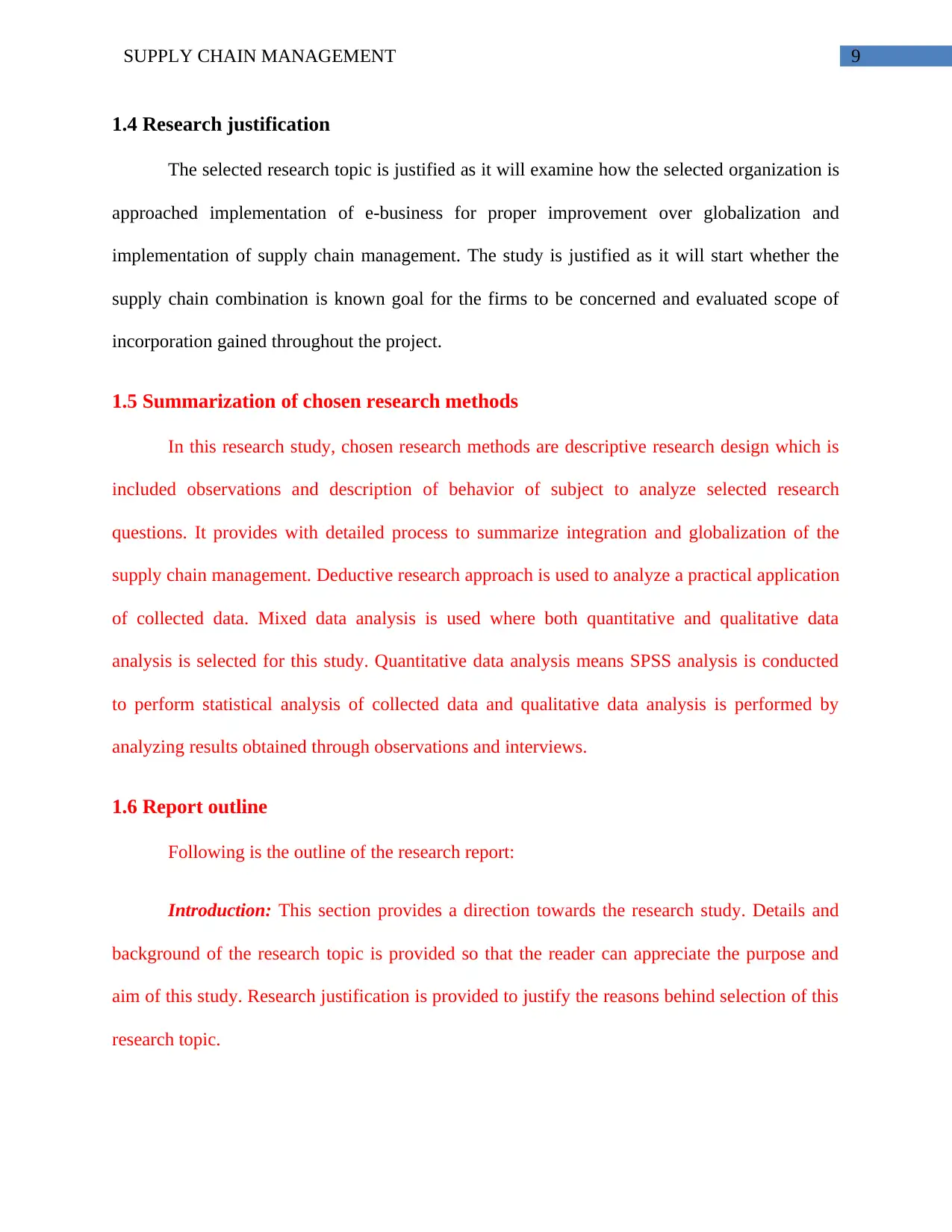
9SUPPLY CHAIN MANAGEMENT
1.4 Research justification
The selected research topic is justified as it will examine how the selected organization is
approached implementation of e-business for proper improvement over globalization and
implementation of supply chain management. The study is justified as it will start whether the
supply chain combination is known goal for the firms to be concerned and evaluated scope of
incorporation gained throughout the project.
1.5 Summarization of chosen research methods
In this research study, chosen research methods are descriptive research design which is
included observations and description of behavior of subject to analyze selected research
questions. It provides with detailed process to summarize integration and globalization of the
supply chain management. Deductive research approach is used to analyze a practical application
of collected data. Mixed data analysis is used where both quantitative and qualitative data
analysis is selected for this study. Quantitative data analysis means SPSS analysis is conducted
to perform statistical analysis of collected data and qualitative data analysis is performed by
analyzing results obtained through observations and interviews.
1.6 Report outline
Following is the outline of the research report:
Introduction: This section provides a direction towards the research study. Details and
background of the research topic is provided so that the reader can appreciate the purpose and
aim of this study. Research justification is provided to justify the reasons behind selection of this
research topic.
1.4 Research justification
The selected research topic is justified as it will examine how the selected organization is
approached implementation of e-business for proper improvement over globalization and
implementation of supply chain management. The study is justified as it will start whether the
supply chain combination is known goal for the firms to be concerned and evaluated scope of
incorporation gained throughout the project.
1.5 Summarization of chosen research methods
In this research study, chosen research methods are descriptive research design which is
included observations and description of behavior of subject to analyze selected research
questions. It provides with detailed process to summarize integration and globalization of the
supply chain management. Deductive research approach is used to analyze a practical application
of collected data. Mixed data analysis is used where both quantitative and qualitative data
analysis is selected for this study. Quantitative data analysis means SPSS analysis is conducted
to perform statistical analysis of collected data and qualitative data analysis is performed by
analyzing results obtained through observations and interviews.
1.6 Report outline
Following is the outline of the research report:
Introduction: This section provides a direction towards the research study. Details and
background of the research topic is provided so that the reader can appreciate the purpose and
aim of this study. Research justification is provided to justify the reasons behind selection of this
research topic.
Paraphrase This Document
Need a fresh take? Get an instant paraphrase of this document with our AI Paraphraser
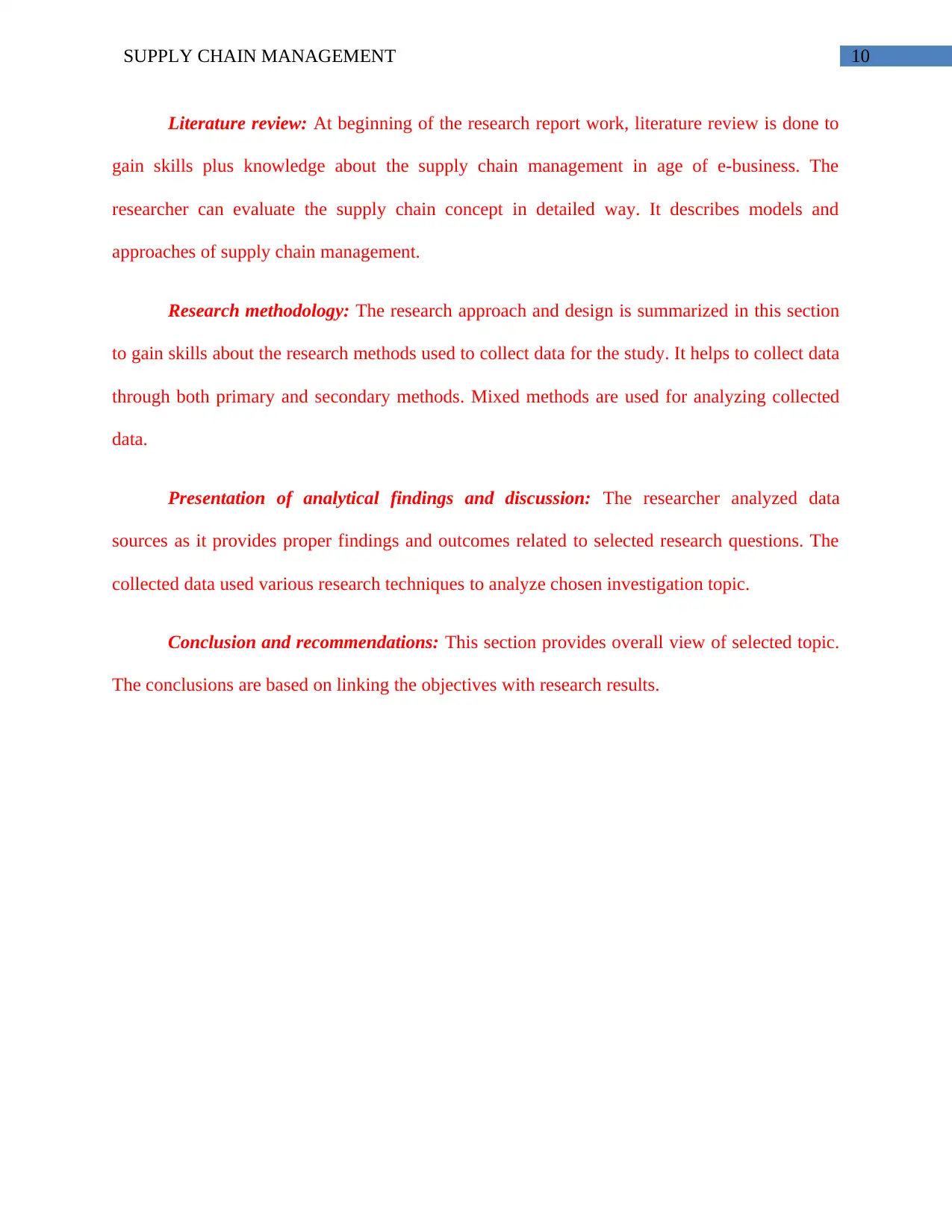
10SUPPLY CHAIN MANAGEMENT
Literature review: At beginning of the research report work, literature review is done to
gain skills plus knowledge about the supply chain management in age of e-business. The
researcher can evaluate the supply chain concept in detailed way. It describes models and
approaches of supply chain management.
Research methodology: The research approach and design is summarized in this section
to gain skills about the research methods used to collect data for the study. It helps to collect data
through both primary and secondary methods. Mixed methods are used for analyzing collected
data.
Presentation of analytical findings and discussion: The researcher analyzed data
sources as it provides proper findings and outcomes related to selected research questions. The
collected data used various research techniques to analyze chosen investigation topic.
Conclusion and recommendations: This section provides overall view of selected topic.
The conclusions are based on linking the objectives with research results.
Literature review: At beginning of the research report work, literature review is done to
gain skills plus knowledge about the supply chain management in age of e-business. The
researcher can evaluate the supply chain concept in detailed way. It describes models and
approaches of supply chain management.
Research methodology: The research approach and design is summarized in this section
to gain skills about the research methods used to collect data for the study. It helps to collect data
through both primary and secondary methods. Mixed methods are used for analyzing collected
data.
Presentation of analytical findings and discussion: The researcher analyzed data
sources as it provides proper findings and outcomes related to selected research questions. The
collected data used various research techniques to analyze chosen investigation topic.
Conclusion and recommendations: This section provides overall view of selected topic.
The conclusions are based on linking the objectives with research results.

11SUPPLY CHAIN MANAGEMENT
Chapter 2: Literature Review
2.1 Introduction
The literature study is based on providing a comprehensible understanding of the best
practices of the integration of supply chain management and their policies in context of
globalization. The best practices of SCM are used to improve cost effectiveness plus
customer services at the retail sector. Rise in the global markets plus increase in virtual
companies are focused on attention of management on competition between the supply
chains. In this study, supply chain framework is used for considerate supply chain
management with highlighting impact of its incorporation and globalization.
2.2 Supply chain management (SCM) and Enterprise Resource Planning
Pedrosoet al.4 stated that SCM is broad range of the activities which are required to
manage and accomplish the flow of products from acquiring the raw materials plus production
throughout distribution to final customers. The goal of SCM in selected Grocery Retail Company
is to enhance the productivity, entire bottom line along with efficiency of the company. Peng et
al.5 argued that SCM is encompassed integrated planning as well as executing of procedures
needed to optimize flow of the materials and information. In the Enterprise Resource Planning
(ERP) environment, the SCM is not a discipline. It is part of business with various dependencies
4Pedroso, Carolina Belotti, Andrea Lago da Silva, and Wendy Lea Tate. "Sales and Operations Planning (S&OP):
insights from a multi-case study of Brazilian organizations." International Journal of Production Economics 182
(2016): 213-229.
5Peng, Jianping, Jing Quan, Guoying Zhang, and Alan J. Dubinsky. "Mediation effect of business process and
supply chain management capabilities on the impact of IT on firm performance: Evidence from Chinese
firms." International journal of information management 36, no. 1 (2016): 89-96.
Chapter 2: Literature Review
2.1 Introduction
The literature study is based on providing a comprehensible understanding of the best
practices of the integration of supply chain management and their policies in context of
globalization. The best practices of SCM are used to improve cost effectiveness plus
customer services at the retail sector. Rise in the global markets plus increase in virtual
companies are focused on attention of management on competition between the supply
chains. In this study, supply chain framework is used for considerate supply chain
management with highlighting impact of its incorporation and globalization.
2.2 Supply chain management (SCM) and Enterprise Resource Planning
Pedrosoet al.4 stated that SCM is broad range of the activities which are required to
manage and accomplish the flow of products from acquiring the raw materials plus production
throughout distribution to final customers. The goal of SCM in selected Grocery Retail Company
is to enhance the productivity, entire bottom line along with efficiency of the company. Peng et
al.5 argued that SCM is encompassed integrated planning as well as executing of procedures
needed to optimize flow of the materials and information. In the Enterprise Resource Planning
(ERP) environment, the SCM is not a discipline. It is part of business with various dependencies
4Pedroso, Carolina Belotti, Andrea Lago da Silva, and Wendy Lea Tate. "Sales and Operations Planning (S&OP):
insights from a multi-case study of Brazilian organizations." International Journal of Production Economics 182
(2016): 213-229.
5Peng, Jianping, Jing Quan, Guoying Zhang, and Alan J. Dubinsky. "Mediation effect of business process and
supply chain management capabilities on the impact of IT on firm performance: Evidence from Chinese
firms." International journal of information management 36, no. 1 (2016): 89-96.
⊘ This is a preview!⊘
Do you want full access?
Subscribe today to unlock all pages.

Trusted by 1+ million students worldwide
1 out of 65
Related Documents
Your All-in-One AI-Powered Toolkit for Academic Success.
+13062052269
info@desklib.com
Available 24*7 on WhatsApp / Email
![[object Object]](/_next/static/media/star-bottom.7253800d.svg)
Unlock your academic potential
Copyright © 2020–2025 A2Z Services. All Rights Reserved. Developed and managed by ZUCOL.





